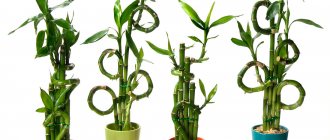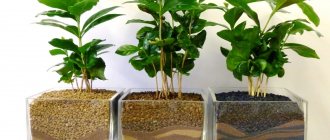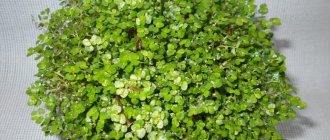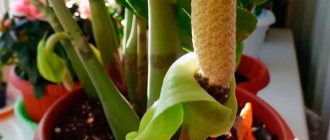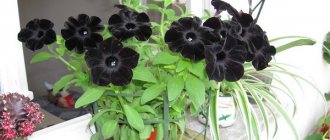Today, almost all summer residents grow various varieties of flowers on their personal plot. For many, this activity is just a hobby, but someone is planting beautiful plants for sale. But be that as it may, any flowers need care. How to keep petunia in winter? This question is of interest to many novice florists. And this is not surprising, because storing flowers in winter is a good way to preserve rare varieties for subsequent planting, if the plant does not propagate by seed. But what methods of storing petunias in winter are there, as well as how to properly plant and care for planting material?
Petunia in winter: how to keep petunia until spring
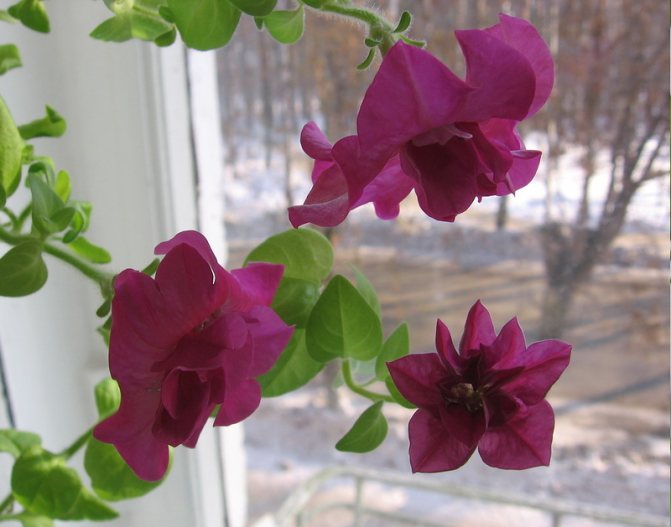
Cold weather is approaching, and petunia on your site or balcony continues to delight in lush color. Soon this beauty will end, but it's a pity ... Well, there is nowhere to go from the cycle of seasons, but you can try to save petunia bushes for the winter. Petunia, in essence, is a thermophilic perennial, therefore, by creating “southern” conditions for it, we can extend its life. So, now we will reveal the secret of how to preserve petunia in winter.
Option number 1. Preservation of uterine bushes of petunias in winter
Adult petunia bushes can be saved until spring if they are transferred to a bright and frost-free room. It should be light, humid enough, optimal t = 10-15 ° C (but less will do, the main thing is that the temperature does not drop below 0 ° C). Suitable conditions are on closed verandas, insulated or southern loggias, on the window sills of entrances.
Petunia bushes are dug up, transplanted into pots and brought into the room. You need to have time to do this before frost, that is, in September-November. Dry leaves, damaged, rotten branches are cut off from the plant. A cardinal haircut is also practiced: all branches are cut to 10-15 cm.
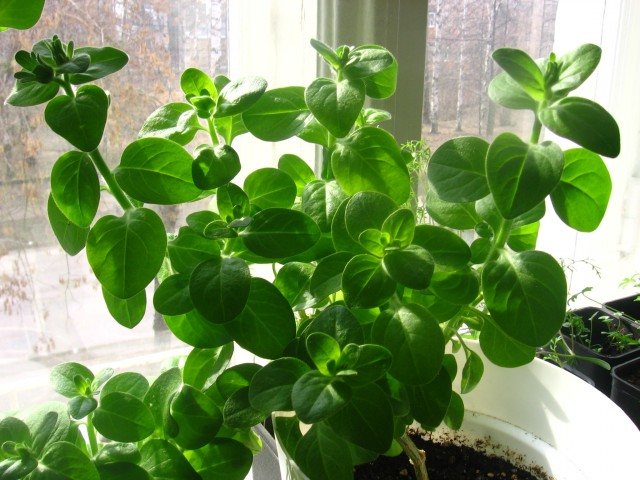

A petunia bush can overwinter on a cold windowsill
The main conditions for caring for petunia bushes in winter:
- minimum watering (up to 2-3 times a month);
- lack of fertilizers;
- high air humidity;
- temperature 10-15 ° C;
- good lighting.
In such conditions, petunias safely survive the winter and bloom in mid-February! Then more frequent watering and feeding can be "introduced" into the diet.
A petunia bush that has survived the winter is planted in open ground or in balcony containers. Or they do it differently: they propagate the petunia by cuttings and grow young petunia plants. The latter option is more common among florists. It is believed (and not unreasonably!) That young petunias bloom better than second years.
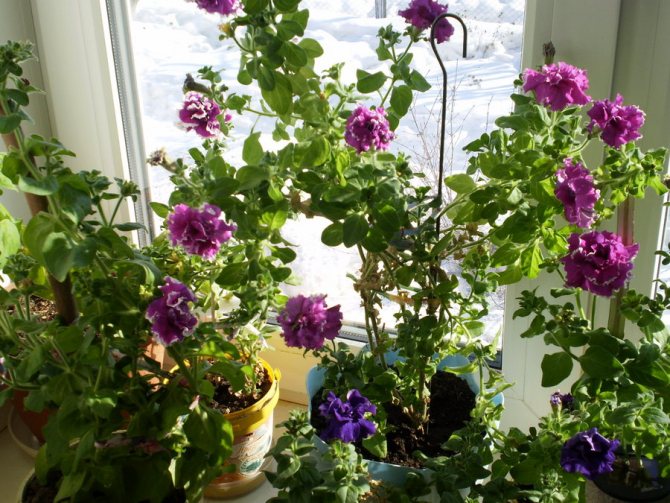

February bloom of petunia in the second year of life
How is petunia cuttings carried out?
In the spring, cuttings of 5-10 cm are cut from the overwintered petunia bush - green, not lignified. The lower leaves on the cutting are cut off so that a bare stem 1-3 cm long remains at the base.It is important that there is at least 1 pair of internodes in this area. 2-3 leaves should remain in the upper part of the cutting. If they are large, then their plates are cut in half across to reduce moisture evaporation.
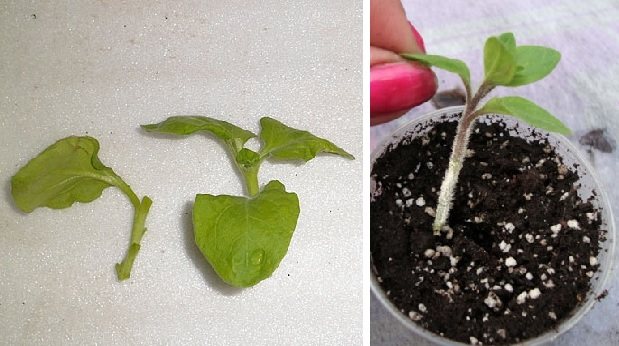

Petunia cuttings are planted in loose soil, preferably with baking powder. Can be used for rooting pure vermiculite or peat
The bare part of the stem is deepened into moist, loose soil.
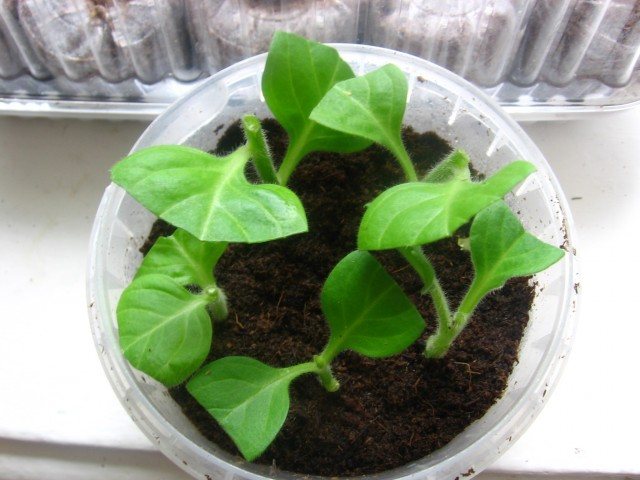

The leaves of the cuttings can be cut in half to reduce moisture loss through the leaf plates
A vapor barrier is arranged on top to maintain high humidity around the cuttings. For example, cover the planting container with a plastic cup, glass jar or glass. Every day, the "greenhouse" is ventilated to prevent mold, rot, and black legs from appearing on the handle.
After about 10-14 days, young shoots will appear in the axils of the cuttings - this means that rooting has taken place! The greenhouse is removed, the cuttings continue to grow in the same way as petunia seedlings: watered, fertilized, sprayed. Above 5-6 leaves, young plants are pinched for tillering.


After 2 weeks, new shoots appear in the leaf axils of petunia cuttings
How to cut petunia is described in the video plot:
In March-April (depending on the region), when stable positive temperatures of 10-12 ° C are established, the rooted cuttings are planted for permanent residence - in open ground or in balcony containers.
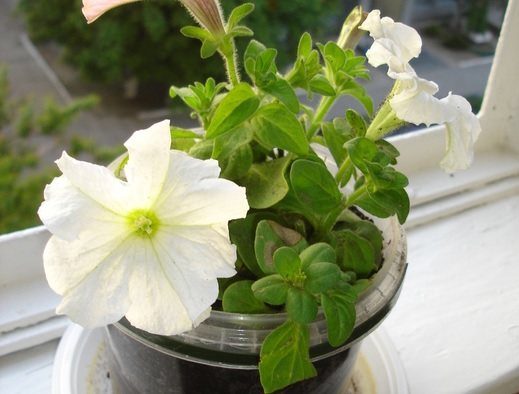

Flowering cuttings of petunia grown from the mother bush - "second year"
Storage preparation
Preparing a petunia plant for dormancy is a crucial and important stage, since it depends on whether it overwinters or not. You can save the flower in the cold period in the form:
If the petunia grew in the ground, then it must be transplanted into a pot. Preservation of uterine bushes begins with pruning the bush from dry leaves, damage, buds. It is important to remove rotten branches so that they do not spoil the healthy branches of the petunia bush. Some growers use a radical method of cutting - all branches are cut to 10 cm above the ground. In this state, the pots are left on the street. You need to have time to bring the petunia into the room before the onset of the first frost.
Preparation of any plant, including petunias, for winter begins before late autumn. For wintering, the flower is cut at the end of summer. During this period, the petunia still has enough vitality and it multiplies easily. Gardeners recommend cutting cuttings 5-10 cm long, after which they are planted in cups and placed in greenhouses. During this period, the rooting of the plant takes place.
After the cuttings of the petunia have become strong, they are transferred to a cool, bright room and provided with appropriate care. In this form, it will be possible to preserve your favorite variety and get not one bush, but several.
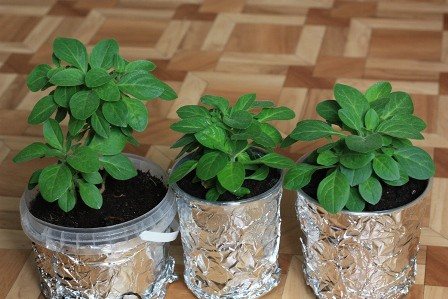

Option number 2. Preserving petunias in winter by cuttings
Keeping petunia mother liquor in winter requires special conditions - high humidity and low temperatures. In a city apartment, with a non-glazed (or glazed, but cold northern) balcony, such a climate is almost impossible to recreate.
In living quarters, not adult petunias have a better chance of survival, but rooted cuttings. They do not need special conditions and need to look after them in the same way as indoor flowers. This method will also help those flower growers who do not want to clutter verandas, balconies and loggias in winter with large containers with petunia queen cells. Cuttings in cups on the windowsills take up very little space!
For winter storage, petunia is cut at the end of August-September. In this petunia cuttings propagate easily, since the life processes in it are not slowed down yet. The plants develop roots 5-10 days after planting.
Cuttings 5-10 cm long are cut from petunias, planted in cups, and covered with a "greenhouse". After rooting, they are placed in a cool, bright place. For example, on the windowsill, closer to the glass. To increase the moisture content of the content, a jar of water can be placed near the young petunias.
The main conditions for keeping rooted cuttings of petunia in winter:
- sufficient watering - after drying the topsoil;
- spraying;
- lack of fertilizers;
- increase in air humidity (containers with water next to the cuttings).
In the spring, cuttings that have already formed into young petunia bushes can be transferred into balcony containers or planted in a flower bed. They can also be cut again and the required amount of planting material can be grown from the new cuttings.
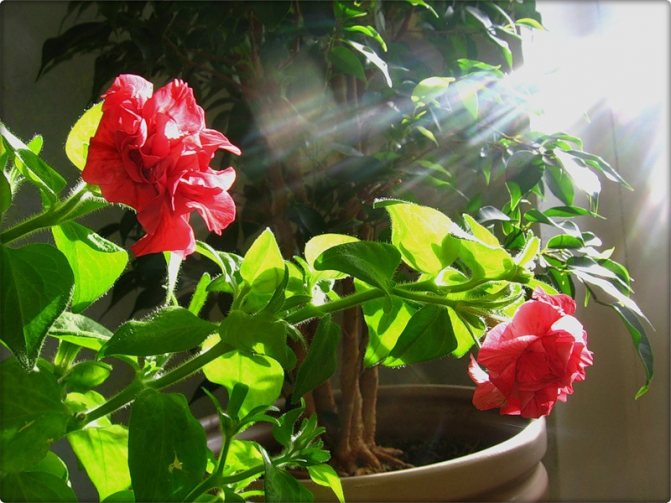

Overwintered cuttings bloom already with the first rays of the warm sun - in February or early March
Preparing for planting pitunia in spring
To prepare the plant for planting in spring, the flower pots that were stored in the basement must be moved to a warm and bright room in February or early spring. So they will have time to wake up, gain strength, sprout.
Read also: Hot water rises up
Then you can start the grafting process. For cuttings, choose the healthiest petunia sprouts with a length of 5-6 cm. After rooting, young sprouts are planted in a substrate, the top layer of which should consist of river sand in order to prevent root decay. Petunia seedlings are watered, fed and planted in the ground or flowerpots.
Benefits of keeping petunias in winter (cuttings or mature plants)
The main advantages of keeping petunias for the winter:
- early spring flowering. An adult “second year” plant or cuttings taken from it can bloom in February-March. And this will happen even in northern regions such as the Urals, Siberia, etc.
- ease of getting adult seedlings. This does not require sowing small seeds, nursing frail sprouts. The planted stalk, after 2-2.5 weeks, will already bloom.
- preservation until spring of vegetatively propagating varieties of petunias.
Advantages and disadvantages of grafting
There are several ways to propagate a plant, but the cuttings method is the simplest. Even a novice agronomist is able to realize what he wants and extend the life of a plant. The benefits of propagation by cuttings:
- All the characteristics of the cultivated variety are preserved, including the color of the flowers.
- The root system forms and develops more actively, as a result the flowers bloom faster.
- You can use this method throughout the year.
- As practice shows, almost all planted cuttings take root.
- Using the seed method of reproduction will require much more effort.
- The most budgetary way to breed a culture. The use of seedlings or seeds is financially costly.
As for the disadvantages, they are absent. The only thing that needs to be adopted by the agronomist is that uterine samples, whose shoots will be used for reproduction, should not have mechanical damage, should be healthy and without obvious signs of pest damage. Otherwise, it will not be possible to propagate petunias, young shoots, most likely, will not take root and die.
Petunias, despite their attractiveness, are rather wayward and capricious flowers. But if you follow agricultural techniques and study all the rules of cuttings, it will delight the eye with lush flowering.
Why is grafting better?
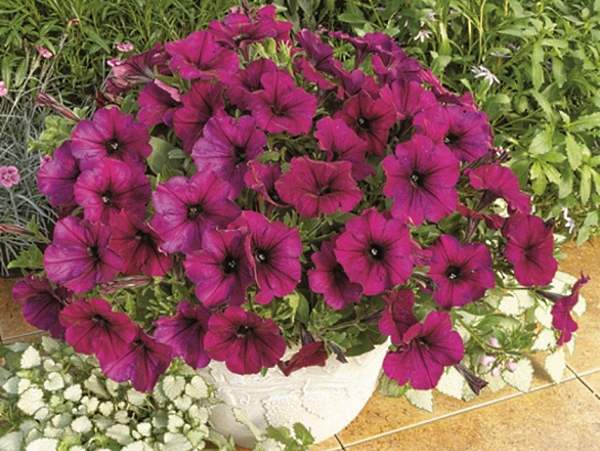

Petunias by type of growth are divided into ampel and bush
.
Ampel petunias grow strongly and become a real decoration of the house and plot. Bush petunia bushes are not so lush.
There are two ways to store petunias in winter - in the form of a mother plant and cuttings
.
In order not to buy the seeds of the petunia hybrids you like, which are not cheap at all in winter, and to grow seedlings over a new one, it is preferable to carry out cuttings of the petunia varieties you like and keep the rooted cuttings in the apartment until spring.
In spring, cuttings grow very quickly and become beautiful bushes.
One more the reason for cutting petunias for the winter
- very often there are spontaneous mutations, especially in terry hybrids. A bush of a certain hybrid grows, suddenly one whip on it gives completely different flowers, they can change shape, size and even color.Thus, Surfinia appeared, it reproduces only by cuttings, there are no seeds in bags.
Packages with seeds, which say that this is Surfinia - rather the seeds of ordinary ampel petunias, at best.
What is lobelia: description and types
Lobelia are herbaceous and shrubby representatives of the Kolokolchikov family, common in the Southern Hemisphere (savannahs of Africa and South America). They were brought to Europe in the 16th century by English colonizers, and were named after the botanist Matthias de Lobel, who at that time was the head of the Royal Botanic Gardens.
lobeliya.jpg
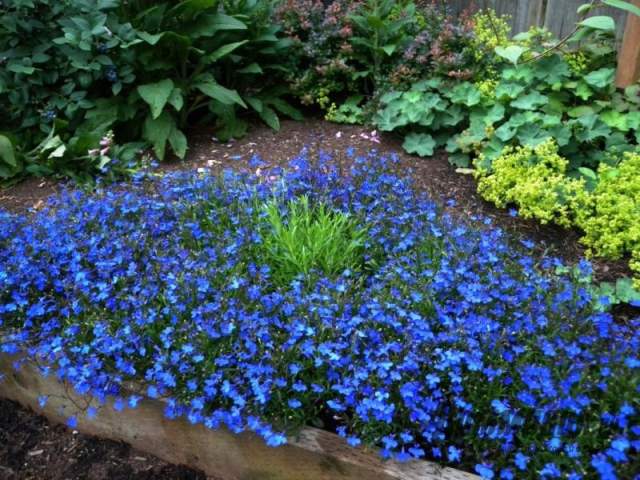

Now scientists have more than 200 species of these flowers, some of them can be found even in the steppe zone of Russia and Ukraine. But wild bushes are not as attractive as artificially bred varieties, and are almost invisible against the background of other grasses. The most popular among the 20 cultivated species is lobelia erinus (black), which is represented by both annual and perennial specimens. They are erect, spherical, ampelous and ground cover - it all depends on the results of selection, which determines the shape of the plants. Varietal characteristics also affect the color of the petals, the size of inflorescences and leaves, and the length of the stems.
lobelia-12.jpg
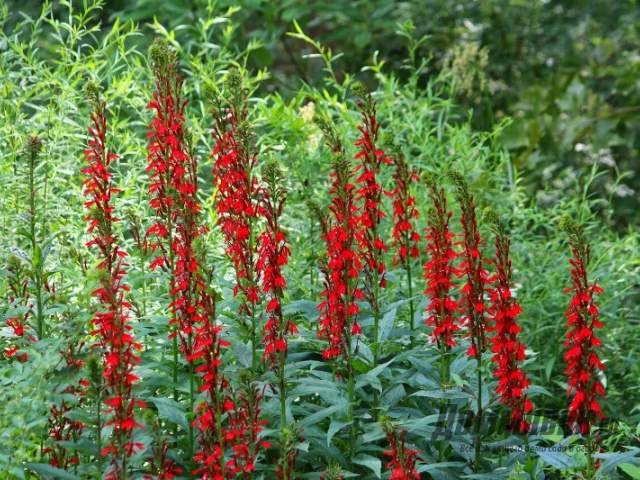

Cutting petunias for the winter
In order to prepare cuttings, the varieties of petunias you like can be cut off or the tops of the lashes, with about 4-6 leaves, cut off the number of cuttings you need. You can cut the whole lash and cut the number of cuttings you need at home.
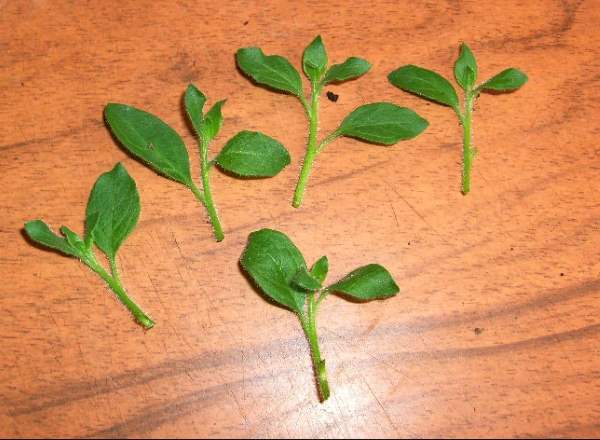

Cuttings
can be rooted in disposable, plastic, 100-gram cups. Use transparent cups so that you can see when the cuttings have roots.
When to cut petunias for storage
For the northern regions, grafting is best done from the end of August, the southern regions start grafting a month later - in September.
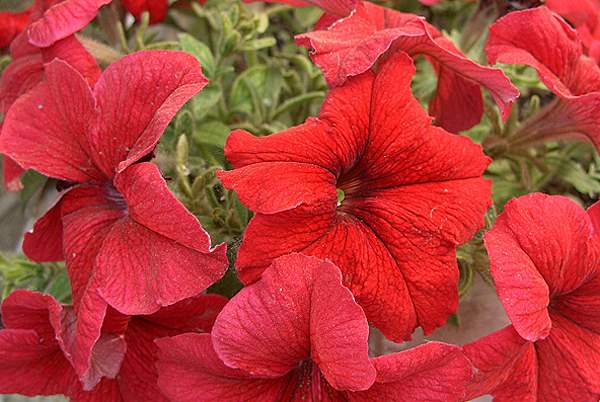

Rooting the cuttings on a light, sunny window will not work - this is not a seedling. Remember that cuttings have no root system - use shelving with lamps
(fluorescent or LED).
The optimum temperature for rooting petunia cuttings is + 15-20 degrees, not less
.
Approximately 1.5 weeks after you have put the cuttings for rooting, you can already look into the bags or look through the transparent walls to see if your plants have roots.
All cuttings with roots can be removed from the bags. We give 5 days to adapt to dry air and then the cuttings can be fed. In the soil without roots, they fed mainly on their leaves.
It makes sense to feed the cuttings only in the first month so that they build up a good root system.
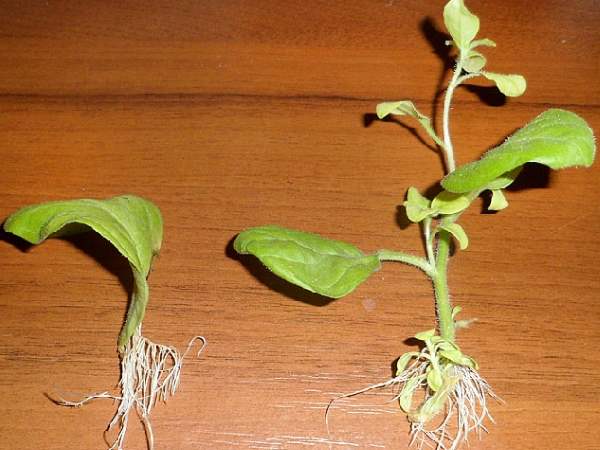

All rooted cuttings are transplanted into 0.5 liter plastic cups
, in them they will grow until mid-January. Use a soil that is water and moisture permeable so that the root system does not rot in winter.
Petunia cuttings are best placed in a cooler place, especially if you cannot provide the plants with sufficient lighting.
Watering in winter is very moderate.
At the beginning of January transplant the cuttings into 2 liter pots
and petunias will grow the root system within a month, and then the leaf mass.
Already in mid February
you can start cutting your favorite plant for the new summer season.
Cuttings are cut in the spring in the same way as in the fall, although cuttings take root much better in spring.
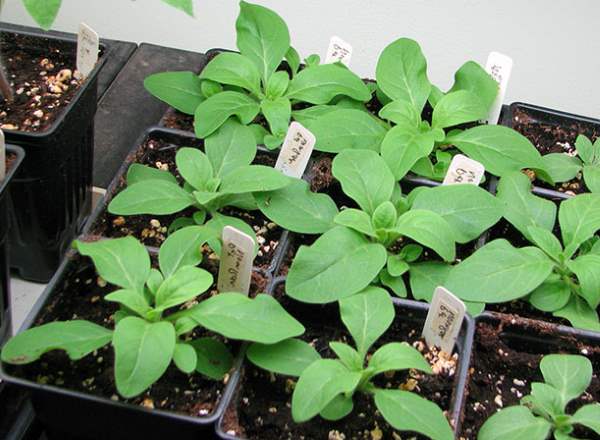

Thus, from one preserved and rooted plant, you can get a huge amount of seedlings, and not a re-grading, but precisely those varieties that you like.
There is no point in grafting bush petunias
- seeds are cheap, there are a lot of seeds in their bags, seedlings of bush petunias are very easy to buy in the spring.
Ampel petunias
sold in packs usually of 5 seeds, you need to choose carefully - the seeds quickly lose their germination.
If you decide to grow ampel petunia with seeds, then propagating them in the spring using cuttings will be very simple. Having sown early seeds for seedlings - at about the beginning of January, petunias will grow up in 1.5-2 months and you can cut off the tips of the branches and carry out cuttings from them.
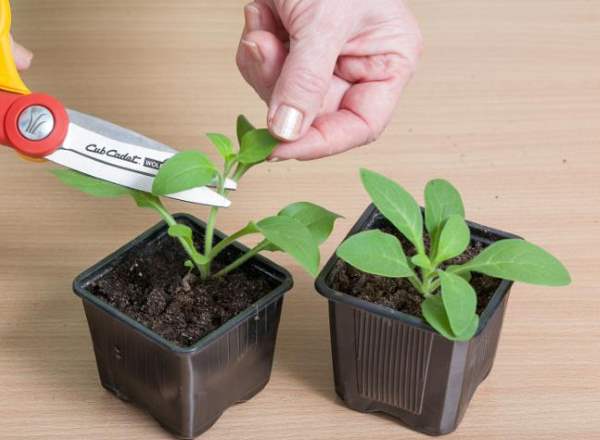

The cuttings will root quickly, and you will get the amount you need from 5 plants.
The main advantages of storing and propagating petunias for the winter is getting early flowering.
Video - Reproduction of petunia by cuttings. How to keep petunia in winter.
Planting petunias for the winter in a pot
The easiest way to preserve petunias at home in winter is to transplant into a pot. This can be done with a flower growing in the open field, and with something that already grew in a flowerpot or street pot. The main thing is to start preparing petunias for wintering before a cold snap.
It is worth cleaning petunia bushes in the house for the winter that do not give seeds or do not retain decorative characteristics in daughter plants. These are, as a rule, F1 hybrids, for example, surfinia, supetunia, etc. It is also suitable for residents of regions where petunia simply does not have time to give seeds due to the very short summer.
In order to bring petunia home for the winter, dig it out with a small clod of earth, after cutting off the shoots. The length of the whips on the petunia should be no more than 10-15 cm - this way it will more easily tolerate a transplant.
Prepare a 2.5-3 liter pot for each flower, pour a layer of drainage (expanded clay, fine gravel, broken brick or foam) on its bottom. Prepare a nutritious soil mixture by mixing for this store soil for flowers and previously disinfected soil from the ridges. Transplant quickly, not letting the earthy coma dry out.
If you grew petunia in a pot or hanging planter, you do not need to transplant it into another container. It will be enough to shorten the shoots to 10-15 cm and take the plant to the house. After 2-3 months (approximately after the New Year), carefully remove the top layer of soil (2-3 cm) from the pot. Pour fresh fertile soil in its place.
Petunia cultivation and care at home
Growing petunias from seeds at home necessarily involves picking. An exception is the method when peat tablets are used when growing seedlings. After the sprouts gain strength, they will acquire five to six full-fledged leaves, they can be seated in separate containers. This process is called picking, it must be done very carefully so as not to damage the fragile root system.
From this time on, the seedlings need to be accustomed to periodic hardening. At first, it will be enough for plants to stay for 10-15 minutes where it is cool - 10-15ºC - with a subsequent increase in the time.
If you want the future petunia bushes to be lush, densely branched, then be sure to pinch them (you can do it more than once). To do this, you need to cut off the growing point of the stem at the level of about the 5th leaf - this technique is to provoke the growth of new shoots from the axillary of the remaining leaves.
When the seedlings gain strength, maybe even give the first flowers, the petunia can be planted in a flower bed.
Cutting petunias for the winter
If some petunia bush seemed especially attractive to you, at the end of the season you can think not only about preserving it, but also about reproduction. The easiest and most reliable way to do this is by cuttings. Not sure how to cut petunia for the winter? Believe me, this process is no different from the standard and very simple.
It is enough to choose a dozen strong twigs on your favorite bush and cut them into cuttings 10-12 cm long. 2-3 pairs of lower leaves should be removed from each, and the upper pair (if it is very large) should be cut in half to reduce moisture evaporation.At least 1 pair of internodes should remain on the handle, so you should not cut it too short - in the pursuit of quantity, the quality of the cuttings can be missed.
For rooting in a container about 10 cm deep, pour a loose substrate, immerse the cuttings in it so that their lower part is 2 cm in the ground. Moisten the soil abundantly, cover the container with a lid or bag so that it is wet inside all the time, and send it to the window. Remember to ventilate your mini greenhouses daily to protect the cuttings from rot and mildew.
After 7-14 days, new leaves will begin to grow on the cuttings, this will mean that the rooting process was successful. The greenhouse can be opened, and small plants can be grown like ordinary seedlings - watered, sprayed, fertilized if necessary.
After about a month (with the formation of 5-6 leaves), the bushes need to be pinched in order to grow more lush. After that, you can plant the petunias in separate containers and keep them in this form until the new season. If the greenhouse was originally wide, replanting is not necessary.
In April-May, the grown bushes are planted for permanent residence. At the same time, they try to focus not on the state of the plants themselves, but on the weather forecast, because petunia is thermophilic, and return frost can nullify all your winter efforts.
You can cut petunia not only in the fall, but also in the spring. To do this, young branches are cut from the overwintered mother bush in March. They choose green, non-lignified shoots, otherwise everything is done according to an already known scheme.
How to keep petunia in winter
However, the preparation itself is not as difficult as keeping the petunia at home in winter. In order for the plants not to die and survive until the next season, you will have to provide them with conditions that are not available in every home.
A mother shrub that has already bloomed in the open field or in a pot should be stored in a well-lit, very humid and cool room. For a good life, the flower needs at least 10 hours of daylight, the air humidity is not lower than 80% and the temperature is not higher than 15 ° C. At the same time, you need to water petunia in winter no more than 2-3 times a month. Such conditions can be provided on a glazed veranda or loggia, in the basement or on a windowsill in a non-residential premises.
Petunia will persist in warmer rooms, but will quickly start growing.
When storing petunias in an apartment in winter, you need to monitor at least the level of humidity and light. If the air around the plant is too dry (and this is usually the case in our housing), the leaves will begin to dry first, then the branches, and then the whole bush will die. If you try to keep petunia as a houseplant without immersing it in "standby mode", it is worth stocking up on powdery mildew and spider mite preparations in advance - they infect the plant in the middle of winter.
Got rooted and rooted petunia is much easier to store. She needs additional lighting and regular watering, i.e. care is carried out as for an ordinary unpretentious indoor flower. Even the problems of petunias in winter are the same as those of other indoor plants.
Already in mid-February, young petunia bushes actively start growing and give buds. From this moment, watering is increased, fertilizing is introduced with complex flower fertilizer (Agricola Aqua, Kemira Tsvetochnoe, Master, Bona Forte for indoor, Ava, etc.), the bushes are transplanted into larger containers. Before planting in a permanent place, petunia can bloom right in the house.
If the bush has grown actively, and it is still far from the warm season, you can re-rough it, providing yourself with the required amount of planting material.
If you are in doubt whether petunias will grow at home in winter, take a chance to check. In the worst case, you will be convinced of the impossibility of this and still have time to sow petunias for seedlings, and at best you will be provided with proven planting material by the beginning of the new season.
How to cultivate correctly?
The best petunia growing technology is:
- Large capacity.
- Regular feeding.
- Sufficient watering.
- Removal of faded flowers.
it the plant loves loamy soil, but it takes root just as well in ordinary garden soil, and some varieties even in simple soil.But it is best to grow a beauty in a fertile one, which consists of peat, turf, river sand, leafy land. Another great option for growing is adding nitrophoska to the soil.
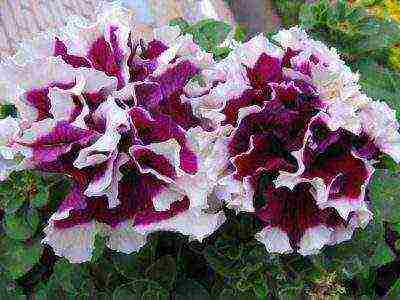

In the garden soil, the green of the plant becomes juicier and its growth accelerates, because they are very fond of a slightly acidic environment.
Growing petunias requires special light conditions. She prefers well-lit growing areas, however, blooms can fade in the scorching sun. Small blackouts are also needed.
Lighting is one of the main conditions for growing petunias. Therefore, well-lit areas with blackouts are ideal.
The soil in which the petunia grows should be moist, but not flooded. An excess of moisture will stop its growth. It is also important to ventilate the soil in which the plant grows. Growing these flowers will not be difficult if you just follow the conditions of lighting, watering and soil composition.
How to keep petunia at home in winter?
A little more and November will come. And in the flower beds, cheerful petunias are still here and there. Proper care of plants during the active growing season has done its job - provided long-term flowering of these charming plants. And the weather did not disappoint this year. Both summer and autumn were generous with warm days. There were few windy and wet days, which flowering plants do not like so much.
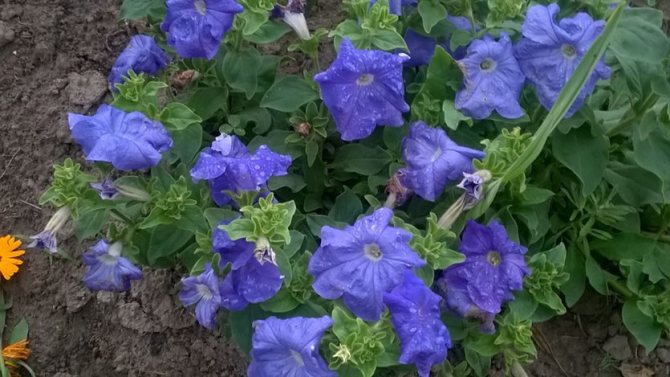

On the eve of the end of the season, let's try to extend the joy of communicating with our favorite flowers, keeping the plant until spring. Moreover, you don't have to reinvent the wheel. Experienced flower growers know how to do this and share their advice generously.
There are at least two ways preserve expensive (literally and figuratively) and luxurious varieties of petunias. The first is when the mother plant is stored, the second is when cuttings are stored.
Storing petunias in winter is no more difficult than growing a flower through seedlings. It's even easier to some extent. The main thing is to create suitable conditions.
Storage the first way is as follows. Before the onset of the cold period, until frosts have become a stable phenomenon, an adult petunia bush with a lump of earth is dug up. It may be October or November depending on the weather and region. Dried leaves and damaged shoots are cut off from him. Radical pruning of all stems is possible, but not completely. Leave 15 centimeters.
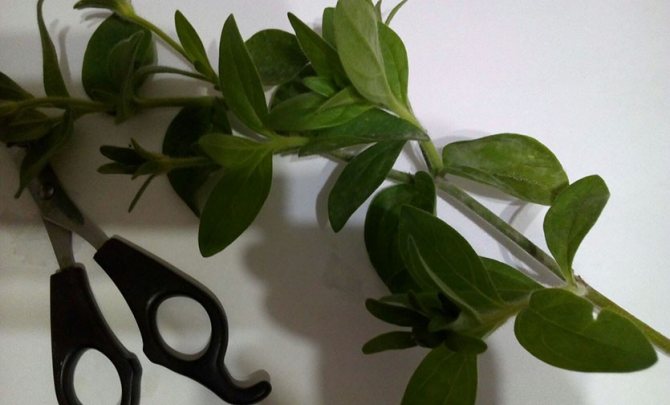

The dug out and trimmed petunia bushes are transplanted into flower pots or flowerpots with a drainage layer and loose nutrient soil. Purchased flower soil or fertile from the garden will do.
The pots are placed in a room that must meet the following requirements - be bright, with good lighting, moderately humid and not freezing. Ideally, the temperature should be about + 10 ° C, even lower is possible, the main thing is not to drop to negative values. A summer kitchen, an insulated balcony or loggia, a closed veranda, as well as any cold window sill are quite suitable for these purposes.
If you manage to find such a place, consider it a success. You should know that until the middle of winter the plants are not fed, they are watered minimally - no more than twice a month. But from the middle of winter, as soon as the growth of young sprouts becomes noticeable, the care becomes complete. Plants are transferred to a warmer (+ 15 ° С), but still bright room with good lighting. Watering becomes regular, plants are fed with nitrogen-containing additives and treated with drugs to stimulate growth. In addition, the topsoil in the pot is renewed. The old one, 2 cm thick, is removed and replaced with a fresh, nutritious and fertile one.
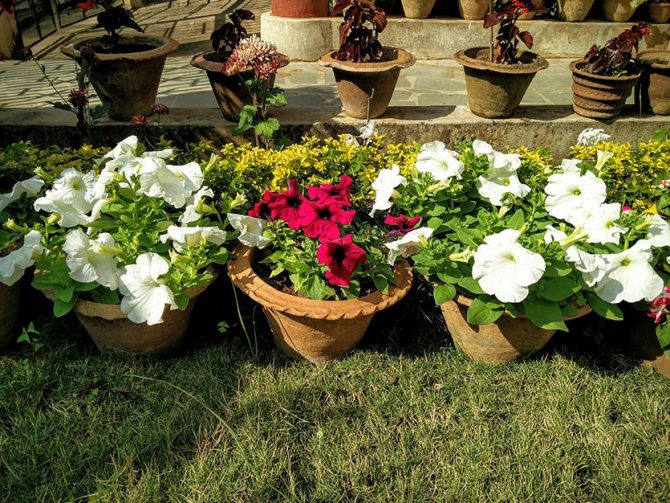

If your petunias did not grow in the open field in the summer, but in containers - containers, then you do not need to transplant anything.After pruning the shoots, bring the containers into the room and grow there, adhering to the above recommendations.
In the spring, the renewed bush can be used for propagation by cuttings. Or, closer to the warmth, plant it back in the flower garden, in the container.
Second way winter storage - cuttings. Cuttings are harvested closer to autumn. The shoots of the plant you like are cut into cuttings about 10 cm long, always with a pair of internodes. In this case, the lower leaves are removed. Cooked small containers, always with a lid, are filled with nutritious, loose, well-moistened soil. When planting, the cuttings are buried into the soil up to 2 cm and covered with a lid until rooting. Rooting occurs quickly enough, since the plant is still full of vitality. You can notice rooting by the regrowth of young leaves.
Cuttings planted in a common container, after rooting, are seated in separate containers. The main requirements for growth: a cool and well-lit room, irrigation (no overflow), spraying, high humidity.
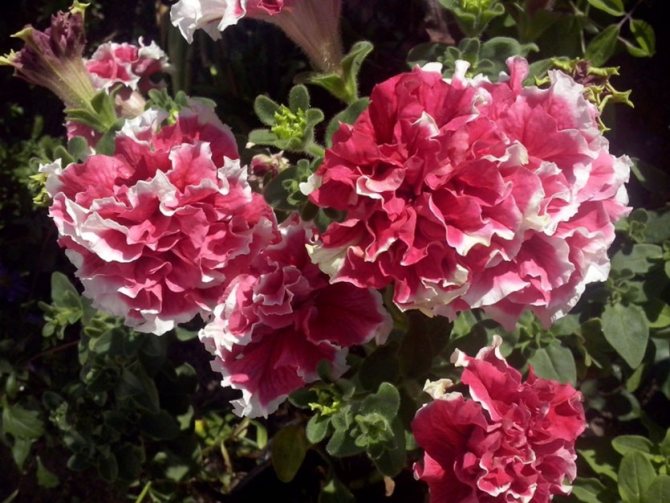

In the spring, young bushes are planted in flower beds or, again, are used for propagation by cuttings.
Preparation for storage does not cause difficulties, the main thing is to ensure optimal conditions of detention. If this succeeds, then in the summer your favorite flowers will again delight you with an unforgettable bright flowering.
Petunia wintering
Few flower growers think that petunia is a perennial by nature. In the harsh conditions of our country, almost everyone grows it as an annual. I propose to consider ways to preserve a chic plant in the winter.
Growing petunias from seeds is troublesome. Not every amateur has the patience to pick microscopic seedlings. Very often, seedlings in the early stages are affected by a black leg. Only a few reach the adult state. Therefore, it makes sense to "try your luck" and keep the items you like at home.
In recent years, several species and varieties of petunias have been bred that do not produce seeds. But they reproduce well vegetatively: surfiniya, calibrachoa, terry hybrids. In order to cut cuttings from them in spring, winter storage of mother liquors is necessary.
Ideal conditions for keeping in winter: • high humidity; • low temperature (not higher than 10 degrees); • rare watering (once a week); • lack of dressing; • good lighting. How to create these conditions and keep the plants until spring?
The uterine bushes that you like are pruned at a height of 18 cm, removing dried leaves and branches. Transplanted into separate containers with a volume of at least 3-5 liters, depending on the size of the plant. At the beginning of autumn, without waiting for a strong cold snap on the street, they first bring it onto the veranda or glazed cool balcony. A month later, they are moved into the house, choosing the coldest place, but with good lighting. In private houses, the following are suitable: an insulated veranda, a window in the basement, a gap between wooden frames (if the distance allows). In apartments, they are located on a warmed or heated balcony, on the windowsill closer to the glass. To reduce the heat, a thick blanket is placed over the batteries. Florists involved in the cultivation of seedlings for the purpose of their implementation, equip the garden with heated greenhouses or greenhouses. If possible, in unheated rooms, the temperature is maintained from 6 to 10 degrees.
What is the advantage of winter storage
Gardeners are not wasting time preserving petunias in the winter.
Unlike planting seeds, this reproduction has several important advantages:
- early flowering: the mother bush or cuttings overwintered indoors can bloom already at the end of February;
- ease of obtaining seedlings: cuttings are much more viable than sprouts grown from seeds;
- preservation of rare hybrids that reproduce exclusively in a vegetative way.
Winter storage of various varieties of petunias may have some individual characteristics. An attentive gardener must monitor the condition of the plants and correct the level of humidity, light and temperature in time.
To obtain the desired result, several flowers should be taken into the house. Even if 1-2 plants die, the likelihood of keeping your favorite hybrid will increase.
Adding an article to a new collection
It is not at all necessary to grow petunia for one year, and in early spring to start fussing with seeds again. There are at least two great ways to keep petunias at home in winter. Moreover, they are suitable for residents of private houses and apartment owners.
It is important to remember that petunias are quite sensitive to cold snaps, so you should not delay rescuing - the very first serious frost can destroy all your hopes. In order for the resettlement of petunias for the winter home to be successful, in the middle lane, carry out all the work no later than the end of September, and in other regions, focusing on the weather forecast and climatic features.
Why is grafting better?
Petunias by type of growth are divided into ampel and bush
.
Ampel petunias grow strongly and become a real decoration of the house and plot. Bush petunia bushes are not so lush.
There are two ways to store petunias in winter - in the form of a mother plant and cuttings
.
In order not to buy the seeds of the petunia hybrids you like, which are not cheap at all in winter, and to grow seedlings over a new one, it is preferable to carry out cuttings of the petunia varieties you like and keep the rooted cuttings in the apartment until spring.
In spring, cuttings grow very quickly and become beautiful bushes.
One more the reason for cutting petunias for the winter
- very often there are spontaneous mutations, especially in terry hybrids. A bush of a certain hybrid grows, suddenly one whip on it gives completely different flowers, they can change shape, size and even color. Thus, Surfinia appeared, it reproduces only by cuttings, there are no seeds in bags.
Packages with seeds, which say that this is Surfinia - rather the seeds of ordinary ampel petunias, at best.
What to do in case of errors
Despite the fact that petunia is considered the most suitable flower for cuttings, florists often make mistakes that prevent the growth and development of the shoot. The first sign of a problem is that the stalk is not rooting. To understand the reason, it is necessary to assess the general condition of the planting.
If the shoot does not take root in the water, rot appears on the cut surface, then the procedure should be repeated. To do this, the process is taken out, the cut is washed, treated with activated carbon. The water is drained, then a fresh portion is poured with the addition of a manganese solution for disinfection.
If rotting begins on a cuttings planted in the soil, then such a shoot cannot be saved. For breeding, a fresh cutting is used with additional processing of the sections and the addition of a growth stimulator.
Cutting petunias for the winter
In order to prepare cuttings, the varieties of petunias you like can be cut off or the tops of the lashes, with about 4-6 leaves, cut off the number of cuttings you need. You can cut the whole lash and cut the number of cuttings you need at home.
Cuttings
can be rooted in disposable, plastic, 100-gram cups. Use transparent cups so that you can see when the cuttings have roots.
You don't need a lot of soil for rooting; you can pour a little more than half into the cups. Priming
should be very loose and breathable. You can add coconut fiber, perlite, vermiculite to the soil composition - the soil will be loose and will be able to keep moisture.
Sprinkle the soil in the cups with plenty of water and prepare the cuttings for rooting.On the cuttings, remove all unblown buds, flowers, seed boxes, old, diseased, yellowed leaves.
Next, with a sharp knife, cut the petunia twigs into cuttings with 4-6 leaves
... Before planting, remember where the top is at the cutting, and where is the bottom, for proper planting in the ground.
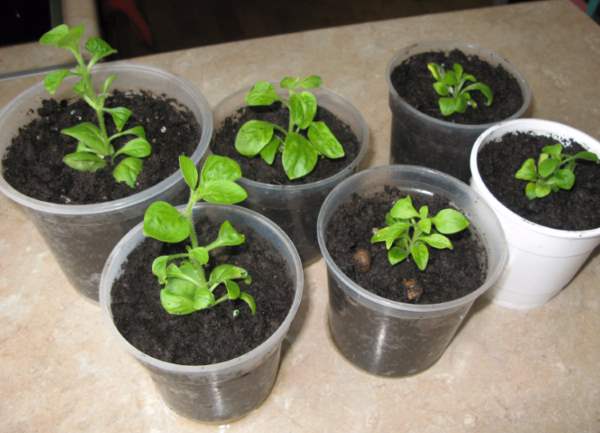

Next, we plant the cuttings in cups with soil, just stick the lower end into the soil. After planting, compact the soil around the cutting. To avoid overflows, do not forget to make drainage holes in the bottom of the cups.
Put the cups with cuttings in transparent plastic bags without holes and tie tightly. Thus, it will be supported desired humidity
so that plants without roots do not die.
Put the cuttings under the lamp
, they will take root for 1-2 weeks, it all depends on the variety.
When to cut petunias for storage
For the northern regions, grafting is best done from the end of August, the southern regions start grafting a month later - in September.
Rooting the cuttings on a light, sunny window will not work - this is not a seedling. Remember that cuttings have no root system - use shelving with lamps
(fluorescent or LED).
The optimum temperature for rooting petunia cuttings is + 15-20 degrees, not less
.
Approximately 1.5 weeks after you have put the cuttings for rooting, you can already look into the bags or look through the transparent walls to see if your plants have roots.
All cuttings with roots can be removed from the bags. We give 5 days to adapt to dry air and then the cuttings can be fed. In the soil without roots, they fed mainly on their leaves.
It makes sense to feed the cuttings only in the first month so that they build up a good root system.
All rooted cuttings are transplanted into 0.5 liter plastic cups
, in them they will grow until mid-January. Use a soil that is water and moisture permeable so that the root system does not rot in winter.
Petunia cuttings are best placed in a cooler place, especially if you cannot provide the plants with sufficient lighting.
Watering in winter is very moderate.
At the beginning of January transplant the cuttings into 2 liter pots
and petunias will grow the root system within a month, and then the leaf mass.
Already in mid February
you can start grafting your favorite plant for the new summer season.
Cuttings are cut in the spring in the same way as in the fall, although cuttings take root much better in spring.
Thus, from one preserved and rooted plant, you can get a huge amount of seedlings, and not a re-grading, but precisely those varieties that you like.
There is no point in grafting bush petunias
- seeds are cheap, there are a lot of seeds in their bags, seedlings of bush petunias are very easy to buy in the spring.
Ampel petunias
sold in packs usually of 5 seeds, you need to choose carefully - the seeds quickly lose their germination.
If you decide to grow ampel petunia with seeds, then propagating them in the spring using cuttings will be very simple. Having sown early seeds for seedlings - at about the beginning of January, petunias will grow up in 1.5-2 months and you can cut off the tips of the branches and carry out cuttings from them.
The cuttings will root quickly, and you will get the amount you need from 5 plants.
The main advantages of storing and propagating petunias for the winter is getting early flowering.


